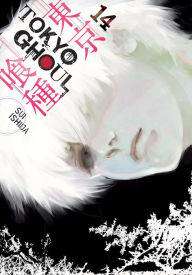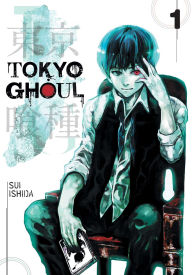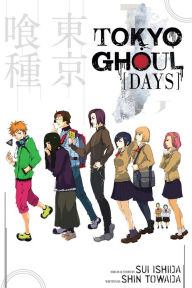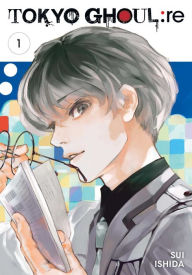The End of Tokyo Ghoul: A Conversation with Manga Editor Joel Enos
Tokyo Ghoul, Vol. 14
Tokyo Ghoul, Vol. 14
By Sui Ishida
In Stock Online
Paperback $14.99
Tokyo Ghoul comes to an end this month with the release of volume 14, but for Joel Enos, who edits the English-language version for Viz, the journey ended some time ago. In fact, he has already moved on to editing the sequel, Tokyo Ghoul: re.
It’s doubtful anyone else has done as close a reading of Tokyo Ghoul as Enos, because that’s what editing a book demands, and over the course of the series I’ve enjoyed talking to him about what he thinks of the story and what I could expect in future volumes.
Now that it’s done, I sat down with him to reflect on the series as a whole—why he thinks it’s so popular (I have my own theories), and how spending two years editing it has affected him.
Tokyo Ghoul comes to an end this month with the release of volume 14, but for Joel Enos, who edits the English-language version for Viz, the journey ended some time ago. In fact, he has already moved on to editing the sequel, Tokyo Ghoul: re.
It’s doubtful anyone else has done as close a reading of Tokyo Ghoul as Enos, because that’s what editing a book demands, and over the course of the series I’ve enjoyed talking to him about what he thinks of the story and what I could expect in future volumes.
Now that it’s done, I sat down with him to reflect on the series as a whole—why he thinks it’s so popular (I have my own theories), and how spending two years editing it has affected him.
Tokyo Ghoul, Vol. 1
Tokyo Ghoul, Vol. 1
By Sui Ishida
In Stock Online
Paperback $14.99
When I first heard about Tokyo Ghoul, I have to admit I didn’t think it was a very remarkable premise. Then I started reading it and was dragged in. What do you think is the hook for this story?
In a weird way, it’s the same reason, fundamentally, that Spider-Man works. It’s the teen angst experience: Being the other, and feeling like you straddle the line between what you’re supposed be like—what everybody else is doing—and discovering this new world that you don’t know how to operate in. I feel like that’s universal: finding your place.
I think what we may have missed early on was thinking it was just sort of zombies, because there was a lot of that going on. He gets bitten and as the story progresses, you know that it’s not just the bite. He’s had these organs put into him, there’s all these experiments, so it even to me has a bit of a Matrix feel to it, where you find out you’re not really who other people thought you were, and maybe you’re not who you thought you were, too, and you have to find out your own way.
So the hook is that everybody has that experience—formative years, figuring out who you are—and it’s something different than what you expected.
And the horror is done well. We don’t actually have a lot of straight-up horror manga. Sometimes it’s mixed with more Victorian gothic storytelling or the shoujo style. This is just straight-up seinen horror, which is why it is hard for me to edit. I like scary stuff, but I’m not a big gory-horror fan.
When I first heard about Tokyo Ghoul, I have to admit I didn’t think it was a very remarkable premise. Then I started reading it and was dragged in. What do you think is the hook for this story?
In a weird way, it’s the same reason, fundamentally, that Spider-Man works. It’s the teen angst experience: Being the other, and feeling like you straddle the line between what you’re supposed be like—what everybody else is doing—and discovering this new world that you don’t know how to operate in. I feel like that’s universal: finding your place.
I think what we may have missed early on was thinking it was just sort of zombies, because there was a lot of that going on. He gets bitten and as the story progresses, you know that it’s not just the bite. He’s had these organs put into him, there’s all these experiments, so it even to me has a bit of a Matrix feel to it, where you find out you’re not really who other people thought you were, and maybe you’re not who you thought you were, too, and you have to find out your own way.
So the hook is that everybody has that experience—formative years, figuring out who you are—and it’s something different than what you expected.
And the horror is done well. We don’t actually have a lot of straight-up horror manga. Sometimes it’s mixed with more Victorian gothic storytelling or the shoujo style. This is just straight-up seinen horror, which is why it is hard for me to edit. I like scary stuff, but I’m not a big gory-horror fan.
Tokyo Ghoul: Days
Tokyo Ghoul: Days
By
Shin Towada
Created by
Sui Ishida
Translator
Morgan Giles
In Stock Online
Paperback $12.99
How do you think the gory aspect works with the story?
Probably with getting the impact of some things that happen, and how those experiences teach us or shape us into the people that we are. We react very strongly to things that are gross or scary or weird or painful. So I think there is a little bit of an allegory of that growing up experience and having to do some things you didn’t think you could do or wanted to. It’s really intense, but the bigger question is why horror is so interesting to people. You’re kind of living out your fears and getting that rush of adrenaline.
The series as a whole is almost like three different genres: It starts out with Ken getting to know the ghouls in the Anteiku coffeehouse, then it goes into the whole Aogiri Tree thing and it becomes much more of a battle, and after that, the conspiracy story comes into the forefront.
And you even get detectives thrown into it who are actually trying to figure out what’s going on, and you have the One-Eyed Owl—is that real or not? Is it a myth? I guess “myth” is a good word—the mythology of the series is getting bigger and bigger, and the world keeps expanding. And in a way, you can relate that back to what everybody goes through. Once you get through your growing pains, you start to see the world in a different way. It expands. It’s not just about you, and you can either find commonality, or stronger differences. I feel like there’s a lot of the human experience in it.
It’s well written, too. The art is great, the story is really tight. Sometimes in the later volumes it feels like it changed a little bit, like you said, but when you really look at it as a whole, the story just kept getting bigger.
I get the feeling he had plotted it out from the beginning, because there are things that occur really early in the series that come up again later, like he’s dropping pebbles along the way.
Yes, like the bite not being explained, and then the doctor coming into it, and then also realizing it’s the RC cells that actually activate things, or the gland—it’s a slow reveal of how this all works.
How do you think the gory aspect works with the story?
Probably with getting the impact of some things that happen, and how those experiences teach us or shape us into the people that we are. We react very strongly to things that are gross or scary or weird or painful. So I think there is a little bit of an allegory of that growing up experience and having to do some things you didn’t think you could do or wanted to. It’s really intense, but the bigger question is why horror is so interesting to people. You’re kind of living out your fears and getting that rush of adrenaline.
The series as a whole is almost like three different genres: It starts out with Ken getting to know the ghouls in the Anteiku coffeehouse, then it goes into the whole Aogiri Tree thing and it becomes much more of a battle, and after that, the conspiracy story comes into the forefront.
And you even get detectives thrown into it who are actually trying to figure out what’s going on, and you have the One-Eyed Owl—is that real or not? Is it a myth? I guess “myth” is a good word—the mythology of the series is getting bigger and bigger, and the world keeps expanding. And in a way, you can relate that back to what everybody goes through. Once you get through your growing pains, you start to see the world in a different way. It expands. It’s not just about you, and you can either find commonality, or stronger differences. I feel like there’s a lot of the human experience in it.
It’s well written, too. The art is great, the story is really tight. Sometimes in the later volumes it feels like it changed a little bit, like you said, but when you really look at it as a whole, the story just kept getting bigger.
I get the feeling he had plotted it out from the beginning, because there are things that occur really early in the series that come up again later, like he’s dropping pebbles along the way.
Yes, like the bite not being explained, and then the doctor coming into it, and then also realizing it’s the RC cells that actually activate things, or the gland—it’s a slow reveal of how this all works.
Tokyo Ghoul, Vol. 6
Tokyo Ghoul, Vol. 6
By Sui Ishida
In Stock Online
Paperback $12.99
There’s a lecture about ghoul physiology in volume 6, but I feel like I would have understood the story better if it was in volume 1.
I think that was part of it, because that’s right around when the story changed, the new characters came in, and the dynamic altered. I think in the beginning you do need to see it through Kaneki’s eyes, and he does not know what’s going on. That’s your entryway.
Now that you’ve gone from the beginning to the end, how do you feel about the manga—and has it changed you in any way?
What’s interesting is it’s probably got some of the darker things that I’ve ever worked on in it. It went to a darker place than I’m used to [seeing] in the thing I work on or choose to work on, so it was interesting to go on that journey with it. I appreciate the story, and I really like what happened. It’s very interesting to me. But I may not have chosen to stick with it if I was just reading it. I don’t mean that in a negative way at all.
I do feel like you almost went through a process with it.
Yes, because it changed a lot. Like I said, it was almost like scary Spider-Man, and then changed into a detectives and mystery, and by the last three volumes, it’s just pretty much pure, all-out, bone-crunching gross. [laughs] But it fits.
It’s not gratuitous.
It’s just like when you make yourself watch all the way through a scary movie [that] goes scarier than you expected.
Were there any surprises for you?
I thought the whole thing was actually surprising in a way, because it did change a lot—so much is thrown in there, the intricacy of the storylines. It wasn’t boring to work on or read. Not that most things are.
There’s a lecture about ghoul physiology in volume 6, but I feel like I would have understood the story better if it was in volume 1.
I think that was part of it, because that’s right around when the story changed, the new characters came in, and the dynamic altered. I think in the beginning you do need to see it through Kaneki’s eyes, and he does not know what’s going on. That’s your entryway.
Now that you’ve gone from the beginning to the end, how do you feel about the manga—and has it changed you in any way?
What’s interesting is it’s probably got some of the darker things that I’ve ever worked on in it. It went to a darker place than I’m used to [seeing] in the thing I work on or choose to work on, so it was interesting to go on that journey with it. I appreciate the story, and I really like what happened. It’s very interesting to me. But I may not have chosen to stick with it if I was just reading it. I don’t mean that in a negative way at all.
I do feel like you almost went through a process with it.
Yes, because it changed a lot. Like I said, it was almost like scary Spider-Man, and then changed into a detectives and mystery, and by the last three volumes, it’s just pretty much pure, all-out, bone-crunching gross. [laughs] But it fits.
It’s not gratuitous.
It’s just like when you make yourself watch all the way through a scary movie [that] goes scarier than you expected.
Were there any surprises for you?
I thought the whole thing was actually surprising in a way, because it did change a lot—so much is thrown in there, the intricacy of the storylines. It wasn’t boring to work on or read. Not that most things are.
Fairy Cube, Volume 1
Fairy Cube, Volume 1
By Kaori Yuki
Paperback $8.99
What was your favorite thing, and what was your least favorite thing?
I think it’s always really fun to work on something so many people identify with. You know, you can have your lost children favorites where you’re like “Oh, Fairy Cube is so good, why didn’t you read it?” and there’s a special place for those. Going to my first convention after the first three volumes came out, and seeing everyone wearing the mask and [cosplaying as] the characters, I was like, “Oh my God, this is going to be huge!” I didn’t expect it. So that’s always fun for me, because once it connects, people want to talk about it.
As an editor for manga especially, you are the keeper. You’re not the writer, you’re not the artist, you’re the project manager on an edition of it. It’s an odd feeling. You’re a little bit removed, but then you’ve put so much time into it. For me, for the English edition, I’m the one thinking about the audience. I’m not making the story, but I’m thinking about how it will be perceived. So it’s nice when something works that you were hoping would—and it did. That’s the best part. I feel that about Naruto, and I feel that about other things I worked on too. I like talking to the fans. I’m a poor [stand-in] for the manga creator, but it is nice to get that acknowledgment.
The challenge was just how violent it got sometimes. I’ve actually said on panels, it is really good. If you want to get into manga and you haven’t, it’s something you can start with, because it’s definitely a manga, but the art style is very specific to the creator, the storyline is intricate in a way that it changes, it’s almost got more of a Western storyline. It’s a nice way to start. But I also have to clarify that if you’re not into violence, and people doing awful things to one another, and characters who are kind of evil, it’s going to be hard for you.
What was your favorite thing, and what was your least favorite thing?
I think it’s always really fun to work on something so many people identify with. You know, you can have your lost children favorites where you’re like “Oh, Fairy Cube is so good, why didn’t you read it?” and there’s a special place for those. Going to my first convention after the first three volumes came out, and seeing everyone wearing the mask and [cosplaying as] the characters, I was like, “Oh my God, this is going to be huge!” I didn’t expect it. So that’s always fun for me, because once it connects, people want to talk about it.
As an editor for manga especially, you are the keeper. You’re not the writer, you’re not the artist, you’re the project manager on an edition of it. It’s an odd feeling. You’re a little bit removed, but then you’ve put so much time into it. For me, for the English edition, I’m the one thinking about the audience. I’m not making the story, but I’m thinking about how it will be perceived. So it’s nice when something works that you were hoping would—and it did. That’s the best part. I feel that about Naruto, and I feel that about other things I worked on too. I like talking to the fans. I’m a poor [stand-in] for the manga creator, but it is nice to get that acknowledgment.
The challenge was just how violent it got sometimes. I’ve actually said on panels, it is really good. If you want to get into manga and you haven’t, it’s something you can start with, because it’s definitely a manga, but the art style is very specific to the creator, the storyline is intricate in a way that it changes, it’s almost got more of a Western storyline. It’s a nice way to start. But I also have to clarify that if you’re not into violence, and people doing awful things to one another, and characters who are kind of evil, it’s going to be hard for you.
Tokyo Ghoul: re, Vol. 1
Tokyo Ghoul: re, Vol. 1
By Sui Ishida
In Stock Online
Paperback $12.99
In a way, the violence is more realistic than a lot of other manga.
It is. Those panels—full panels of bones being broken and bites—and what happens [after]. The thing is, it’s hard to say that and not sound negative, because I don’t feel like it’s a negative. It’s part of the story, and it’s what a lot of the fans like. Basically, Tokyo Ghoul is not afraid to be what it is. And I like that. I respect it.
But also, one of the things you get from it, which you don’t always get, is that violence has consequences.
Totally. You see some really dark things happen, and even some of the main characters do some dark things. Everything circles around, and you see the fallout. We all do things like that—things happen, and you realize what you’ve done, and that there are consequences. So again, there’s the universality of going through growing experiences and learning from your mistakes. But ultimately, it’s just a good story and it’s well told.
Tokyo Ghoul, Vol. 14 is available August 15.
In a way, the violence is more realistic than a lot of other manga.
It is. Those panels—full panels of bones being broken and bites—and what happens [after]. The thing is, it’s hard to say that and not sound negative, because I don’t feel like it’s a negative. It’s part of the story, and it’s what a lot of the fans like. Basically, Tokyo Ghoul is not afraid to be what it is. And I like that. I respect it.
But also, one of the things you get from it, which you don’t always get, is that violence has consequences.
Totally. You see some really dark things happen, and even some of the main characters do some dark things. Everything circles around, and you see the fallout. We all do things like that—things happen, and you realize what you’ve done, and that there are consequences. So again, there’s the universality of going through growing experiences and learning from your mistakes. But ultimately, it’s just a good story and it’s well told.
Tokyo Ghoul, Vol. 14 is available August 15.





